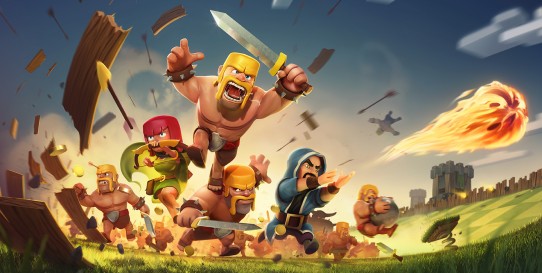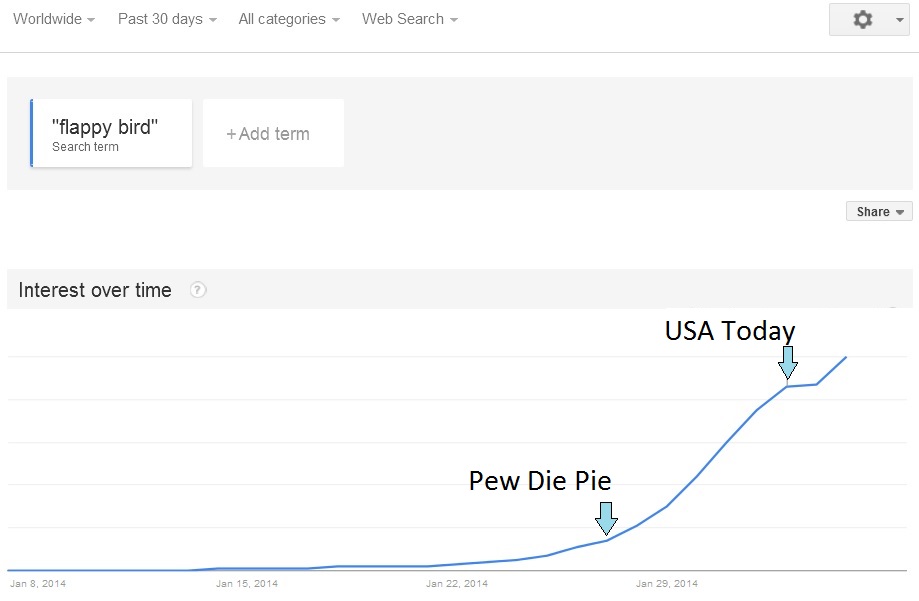The mobile market is still growing fast; in 2014 the number of mobile-connected devices will exceed the world’s population. With over 1 million apps available on both the iTunes App Store and Google Play, the competition facing mobile developers is fiercer than ever before. With so many app options, the sheer volume of marketing has grown to a cacophony… so where does this leave mobile app PR? The market has shifted substantially over the past year, and PR pros must adapt rapidly. Formerly bulletproof techniques have become less reliable, while new PR strategies are evolving in their place. All this upheaval is thanks to three little characters: F2P.
The massive growth of free-to-play has transformed the app landscape. According to Quartz, citing App Annie and Flurry analytics, freemium apps accounted for 93% of game revenue in 2013. It’s simple to see why; like in the olden days of shareware, freemium works because players get to sample a game and potentially become addicted before they’re ever asked to spend. While there are still paid apps that are fun, high-quality and worthy of attention, the irrefutable truth is that freemium apps generate the vast majority of global app revenue.
At its simplest, the backbone of every review campaign involves getting games in the hands of journalists. For apps, this is done by distributing promo codes. For premium games, just like films, books and music, journalists experience the content free of charge, in exchange for writing up their impressions. There’s a wrinkle, however; once a free-to-play mobile app has launched, it’s publicly available to everyone. Promo codes are rendered irrelevant, acting merely as links to help press locate games without searching the app store. Review pitches from PR pros tend to lose their luster once a game has debuted, but the appeal of getting ‘something for nothing’ doesn’t stop with journalists. Consumers are less likely to read an editorial review for a free app. Rather, they could use that time to download it, try it out, and make the decision to delete or continue playing. As a result, editors-in-chief are less motivated to publish F2P reviews, which draw fewer clicks and advertising impressions than their premium brethren.
When it comes to freemium apps, public relations can make a huge impact at the corporate level. Rather than getting mired in the minutiae of one particular app, a communications strategy that focuses on the studio as a whole can be the smartest approach. Especially when free-to-play apps prioritize a more data-driven approach to game design over pure originality, this shifts the conversation to the studio’s accomplishments at large.
If a developer’s sole goal is to drive app downloads above all else, in some cases PR may not be the solution. However, PR works in many intangible ways, providing a reliable means to attract the attention of investors, publishers, partners, future employees, and perhaps most important of all, the almighty gatekeepers. Yes, the editorial teams at the iTunes App Store and Google Play follow mobile app news, and yes, they will run a web search on every app, publisher and developer before considering them for featured status — the Holy Grail for developers. In an age where people are less inclined to read reviews than to simply browse the top charts, this can make all the difference.
So, when your company or game is searched for online, what pops up first? Effective PR lets app creators set the messaging that surrounds their product. Without it, developers risk letting the internet’s vocal minority set the tone for their game, be it ravenous support or vehement opposition. It’s wiser to have professional journalists from respected news outlets covering the product; they’ll be familiar with the key messages, they’ll provide a tempered, unbiased viewpoint in their reviews, and their opinions have the power to reach millions of potential players across blogs, websites and social channels.
In the majority of cases, PR must be part of a larger marketing effort in order to be truly effective. Without also employing experts in user acquisition, retention and monetization, apps are likely doomed to fall quickly from the top charts. Advertising is important, too. While traditional campaigns like banners and site re-skins are faltering, modern approaches like in-app cross promotion and app-install ads within social networks like Facebook are a valuable source of new players. VentureBeat’s Dean Takahashi put it best: “User acquisition may not be sexy, but it’s critical in mobile games.”
Successful app developers treat their creation as an ongoing service, not a static product. Progressive iteration is necessary for modern apps; developers must isolate the snags their users hit and eliminate them as swiftly as possible. With iOS 6, Apple made the app updating process simpler for consumers by removing the password requirement – just tap ‘update’ within the App Store and the process begins. Today with iOS 7, apps now automatically update in the background. A setting on Android phones also allows users to update their apps automatically.
In mobile gaming, quality still reigns supreme, as evidenced by Zynga’s recent acquisition of app developer NaturalMotion. As Kim-Mai Cutler of TechCrunch points out, “It’s so expensive now to market and acquire users on mobile platforms. So if you’re going to launch a game, it takes much more time and investment than it did a year ago. That’s why a new and even more deliberate approach is necessary. It’s not enough to fast-follow on proven gaming categories, which was Zynga’s strategy on the Facebook platform.” The viability of copycat apps has dropped substantially in the past few years.
Doing It Right™ Case Study: Clash of Clans has become a massive hit by putting fun, rewarding game design at the forefront. Supercell has essentially reverse-engineered both casual building games and mid-core strategy titles of the past to see what make them tick (and what will keep players coming back for more). They slowly introduce new players to the notion of paying by offering lots of free currency and rock-bottom prices early on, letting the addicting gameplay set in gradually over time.
Then there are the seemingly inexplicable successes like Flappy Bird. Occasionally, an app achieves viral hit status so quickly and without precedent that players are left scratching their heads… and saying “just one more try.” It’s tough to make the stars align in this fashion; developers could spend thousands on advertising without getting half the attention Flappy Bird has received. While some doubt the legitimacy of these numbers (under suspicion of bot-downloads), its baffling ascent up the charts may actually be media-driven. The game’s popularity spiked shortly after the world’s #1 most-subscribed YouTuber PewDiePie played Flappy Bird on January 27th, 2014.
That day, there were 14 web headlines about the game, and just one week later, the number had shot up to 87 major news stories. The impact of YouTubers like PewDiePie, particularly in the realm of gaming, has grown substantially over the past few years. As younger players increasingly seek news from non-traditional and non-professional sources like YouTube, the influence of these armchair video bloggers has grown by leaps and bounds.
Just as bloggers leveled-up their prestige during the mid-2000’s, the Let’s Play community is currently gaining mainstream legitimacy. TriplePoint has established relationships with many of these YouTubers like PewDiePie, who recorded a series of 15 videos for indie horror sensation Outlast and nearly 50 million total views. Newer media channels like YouTube and Twitch provide an avenue to reach players where they already spend time, and are a valuable supplement to traditional publications.
The rise of mobile is unstoppable, and the industry grows increasingly cutthroat each year. In just three years, 94.5% of all apps downloaded will be free, while just 0.01% of these will be deemed financially successful. The app stores are simply getting saturated. Of the top 250 American publishers in 2013, only 2% on iOS and 3% on Google Play were newcomers who had not previously released a game. Regardless of platform, there’s a growing need to communicate effectively and stay atop trends for app developers striving to become the next breakout success. For paid and free apps alike, intelligent PR still reigns supreme.
Part 2: Brass Tacks
When it comes to PR for free-to-play apps, there are a variety of specific tactics that can be mixed and matched, depending on the specific app the amount of time remaining before launch.
1) Start earlier. As soon as a F2P app is live, the value of promo codes drops to nearly zero. Thus, it’s important to leverage the appeal of sneak-peek early access, by getting the app to journalists as early as one month or more prior to launch.
2) Set up press tournaments. The majority of freemium apps focus on social elements, but whether it’s competitive or cooperative play, the experience before launch is extremely limited by a lack of players and servers. To skirt this issue, savvy PR pros will orchestrate matches between a handful of journalists and the developers themselves, ensuring there’s always someone available to lend a hand (or foil your battle plans).
3) Deliver free IAP, but don’t require it. The majority of reviewers take a multi-phase approach to analyzing free apps. Initially, they’ll prefer to play the game without spending a cent, experiencing the tutorial and early stages just as an ordinary player would. This helps give a sense of the game’s learning curve, its difficulty ramp-up, and the relative exchange rates and values of the app’s currencies. With a wagon-load of free Smurfberries up front, it’s easy to dive right in, but just how costly do they become (and how necessary will it be to start spending) after a few hours of gameplay? Typically, journalists only become interested in skipping ahead, leveling-up quickly and injecting an IAP-boost at this later date. While it’s wise to give them that option, many reviewers simply will ignore it to maintain a player’s-eye view.
4) Engage the community. Editorial reviews are less common for F2P apps, so to build buzz, smart developers communicate with fans where they’re already spending time online. Having developers available on Reddit for AMA’s and on forums such as Touch Arcade can bolster visibility for both the game and the studio.
5) Data: you’ve got it, so flaunt it! Free-to-play apps are inherently driven by data, since monetization depends on knowing users and their behaviors inside and out. Touting these impressive stats can help gain the attention of press who may have overlooked the game initially; it’s a perfect inroad with tech and business writers. With relative ease, freemium developers can access data, cull through it for interesting statistics, and leverage these to create compelling assets. Infographics are quite popular, and have the potential to elevate a game beyond industry trade publications and onto broader sites like WIRED, The Verge and Mashable.
6) Embrace the soft-launch. On 148Apps, Carter Dotson runs a popular series called It Came from Canada where he evaluates games that are soft-launched in Canada. While these betas aren’t open on a global scale, editorial features such as these ensure that as launch nears, the game is anchored to preview coverage online. The Canadian soft launch is so common that Quora and Forbes teamed up to explore the topic.
7) Nip F2P bias in the bud. “If I can’t win, why should I play?” This is a common refrain among freemium doubters who miss the appeal of social games, city-builders, and others that lack a finite conclusion. It’s important to outline the game’s long-term appeal, providing a rough sense of where the game is going and the evolutions in game design that are slated to occur. Video assets also help convey the game’s competitive nuances, and the fun that can be had strategizing with (or against) friends.
8) Stay on top of updates. Far more than paid games, F2P apps rely on a steady stream of updates to add content, rebalance gameplay and ensure that the game stays challenging for veterans while appealing to newbies. Messaging for these updates must be handled strategically; does the latest one warrant a formal press release? Perhaps a media alert? Or should you just email a dozen or so reliable supporters? These options, plus the possibilities of an exclusive reveal with one outlet, put many arrows in the app update quiver.
Freemium apps are seeing astonishing growth around the world. In the past year, free-to-play app revenue grew from 77% to 84% on iOS, and from 89% to a staggering 98% on Android devices. PR techniques that were once reliable have started to falter, while new strategies are evolving in their place. Truly, the same skills are called upon to succeed in both freemium app development and F2P PR: think creatively, respond nimbly, and stay one step ahead of shifting conditions. And when in doubt, call in a favor from a friend!






